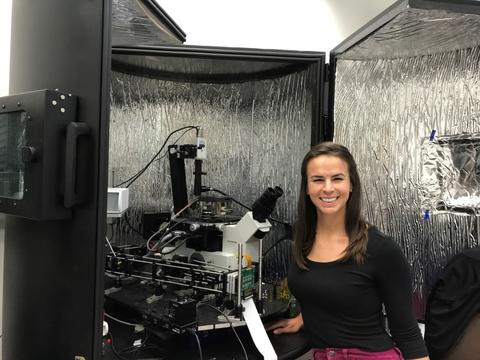
NIST’s Callie Higgins has found a place for herself in an emerging and largely mysterious field within manufacturing.
As a special branch of additive manufacturing, vat photopolymerization uses light to solidify a liquid resin layer by layer into a 3D object. You might already be a little bit familiar with the technique, since dentists also use ultraviolet light to harden polymer resins atop your pearly whites, but it hasn’t been fully explored yet.
Up until 10-15 years ago, the technique was hidden from the broader research community behind a patent, and not many publications existed to explain it. Now, the patent has expired and we’re working together to catch up. This is where Callie, a materials research engineer, thrives.
Callie’s educational background in physics and optics at University of San Diego and then the University of Colorado Boulder put her squarely onto the photopolymerization path, where she learned how to manipulate materials with light and produce structures such as artificial cartilage and bone.
Due to the materials’ light sensitivity, Callie constantly experienced solitude in a dark room throughout her Ph.D. work. She was convinced that the next career step would be to move into a more collaborative space in industry, until a NIST contact asked her to join our ranks as a postdoctoral researcher.
Any initial reservations that Callie felt toward that two-year detour melted away when she recognized NIST’s important role as the bridge between research and industry. Her experience as a facilitator for industry-academia-government discussions around photopolymerization has even kept her at NIST for another two years beyond the postdoctoral program.
Here at NIST, Callie and her team are working with leaders in the commercial world to address some core questions about photopolymerization. For example, how can we make sure that the light in the process stiffens all of the material and not just the areas that it hits the most? Or which materials perform better for solidifying properly with light?
It’s all part of the photopolymerization puzzle, and when we work together to crack it (with researchers like Callie on our side), there’s no telling what innovations await.
Follow us on social media for more like this from all across NIST!

